 | ||
A ring is a round band, usually of metal, worn as an ornamental piece of jewellery around the finger, or sometimes the toe; it is the most common current meaning of the word "ring". Strictly speaking a normal ring is a finger ring (which may be hyphenated); other types of rings worn as ornaments are earrings, bracelets for the wrist, armlets or arm rings, toe rings and torc or neck rings, but except perhaps for toe rings, the plain term "ring" is not normally used to refer to these.
Contents
- History
- Ancient Near East
- Archaic and classical Greek
- Roman Rings
- Finger ring wearing choice of fingers
- Size
- Styles
- Notable individual rings
- Other types
- References
Rings are most often made of metal but can be of almost any material: metal, plastic, stone, wood, bone, glass, or gemstone. They may be set with a stone or stones, often a gemstone such as diamond, ruby, sapphire or emerald.
History
Although tracing the exact history is difficult, the custom of giving and receiving finger rings dates back over approximately 6,000 years.
Ancient Near East
The Hittite civilization produced rings, including signet rings, only a few of which have been discovered. People in Old Kingdom Egypt wore a variety of finger rings, of which a few examples have been found, including the famous scarab design. Rings became more common during the Egyptian middle kingdom, with increasingly complex designs. Egyptians made metal rings but also made rings from faience some of which were used as new year gifts. Native styles were superseded by Greek and Roman fashions during the Ptolemaic dynasty.
Archaic and classical Greek
Archaic Greek rings were to some extent influenced by Egyptian rings, although they tended to be less substantial and apparently weren't for the most part used as working signet rings. A lack of locally available gold meant that rings made in the eastern colonies tended to be made from silver and bronze while Etruria used gold.
The classical period showed a shift away from bronze to wider adoption of silver and gold. The most typical design of the period involved a lozenge bezel mounting an intaglio device. Over time the bezel moved towards a more circular form.
Roman Rings
During the early and middle imperial era (first two centuries AD) the closest there is to a typical Roman ring consisted of a thick hoop that tapered directly into a slightly wider bezel. An engraved oval gem would be embedded within the bezel with the top of the gem only rising slightly above the surrounding ring material. Such rings are referred to Henig II and III/Guiraud 2 in formal academic parlance or simply as Roman rings by modern jewellers. In general Roman rings became more elaborate in the third and fourth centuries AD.
Finger-ring wearing, choice of fingers
The fourth digit or ring finger of the left hand has become the customary place to wear a wedding ring in much of the world, though in certain countries the right hand finger is used. This custom was practically established as the norm during World War II. The use of the fourth finger of the left hand (the 'ring finger') is associated with an old belief that the left hand's ring finger is connected by a vein directly to the heart: the vena amoris or vein of love. This idea was known in 16th and 17th century England, when Henry Swinburne referred to it in his book about marriage. It can be traced back to ancient Rome, when Aulus Gellius cited Appianus as saying the ancient Egyptians had found a fine nerve linking that particular finger to the heart.
Occasionally rings have been re-purposed to hang from bracelets or necklaces.
Size
While the ISO standard defines ring size in terms of the inner circumference in millimeters various countries have traditional sizing systems that are still used.
Styles
After several thousand years of ring manufacture the total number of styles produced is vast. Even cataloging the rings of a single civilization such as the Romans presents a major challenge. As a result, the following list should be considered to be very limited.
